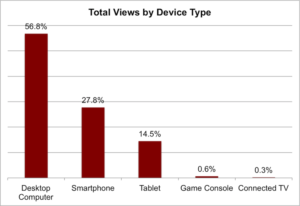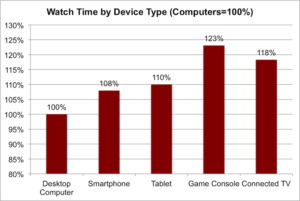How Mobile Changes Viewer Behavior on YouTube
December 7, 2023It’s no secret: We all spend more time than ever looking at smartphone and tablet screens. According to eMarketer, more than half of the U.S. population owns a smartphone, and 44% use a tablet. For many people a mobile device is now their primary way of accessing the Internet.
This shift in behavior has a huge impact on online video consumption. YouTube’s official statistics say that 40% of total watch time is spent on mobile devices. In some countries and for some topics, it’s already well above half.
But what does this mean for marketers? Do consumers behave differently when they watch video content and video ads on mobile devices? How should marketers adapt their YouTube strategy to the rise of mobile?
To answer these questions, Pixability’s data science team looked at the performance of several hundred ad campaigns and a broad selection of YouTube channels across several industries.
Over the course of two blog articles, we will discuss the findings from our data and the implications for marketers. While this is not an in-depth study at this point, our early results show some interesting patterns that marketers should consider when planning their YouTube strategy:
- Traditional desktop computers now account for only about half of all views
In our sample, a total of 56% of all views came from desktop computers, 28% from smartphones and 15% from tablets. Connected TVs and game consoles didn’t play a major role yet, only accounting for one percent of views.
- Viewers spend more time per video when watching on mobile devices
Our analysis found that the average watch time per video compared to traditional desktop browsers was 8% higher on smartphones, and 10% higher on tablets. This result contradicts conventional wisdom that often suggests that people’s attention span is shorter on smaller screens. Our interpretation is that people select interesting content more consciously when watching on mobile devices, while desktop browsers are often used for superficial surfing, jumping from video to video quickly.
- The big screen captures viewers’ attention even more
An interesting fact for future developments in viewer behavior: Watch times on TV screens beat the desktop by an even higher margin. In our sample it was 18% higher on connected TVs, and 23% higher on game consoles. However, these newest forms of YouTube consumption currently play only a small role with less than 2% of all views on almost all channels, so it’s possible that these viewers were early adopters with a particularly high YouTube consumption. - iOS users watch more video
For smartphones, Apple’s iOS devices and Android devices accounted for roughly the same amount of views, although differences between channels were often significant. Given that iOS’s overall smartphone market share is trailing Android significantly, this means that iOS/iPhone users on average watch quite a bit more video. None of the other platforms reached a significant shares of views, so marketers should concentrate on optimizing the experience of iOS and Android users.The picture was even clearer on tablets: iPads accounted for more than half of all tablet views, with Android a distant second. Windows was the only other platform that mattered, significantly behind Android.
In our next blog post we will look at how YouTube ads work differently on mobile devices and share recommendations for YouTube marketers who want to optimize their strategy for mobile.